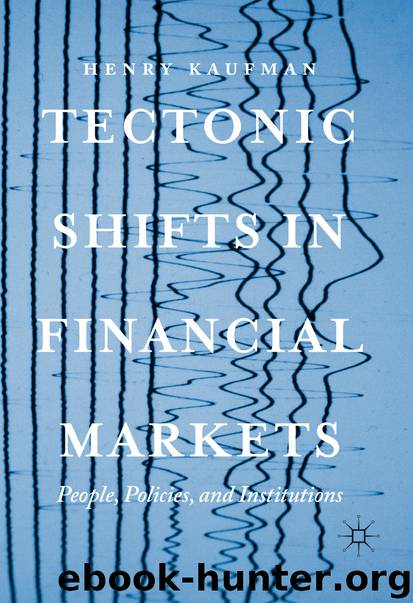Tectonic Shifts in Financial Markets by Henry Kaufman

Author:Henry Kaufman
Language: eng
Format: epub
Publisher: Springer International Publishing, Cham
It is, unfortunately, difficult to imagine a U.S. President discussing economic matters with such sophistication and clarity.
I explained to the Prime Minister that an effective money supply target approach was out of reach. To be sure, Paul Volcker had suddenly switched to monetarism in October 1979, but he had done so as shock therapy, not as a long-term strategy. Too many structural changes in the credit market, I continued, made it increasingly difficult to define the money supply precisely. From my perspective, the financial markets were evolving into a framework in which money mattered but credit counted. Relentless financial innovation was expanding the marketplace and running ahead of official controls. As everyone later came to understand, securitization was sweeping the mortgage market. New credit instruments, especially derivatives, also were expanding the boundaries of credit. Computers allowed for the more intensive use of economic and credit data, which boosted trading activity, and seemed to reduce risk taking—all of which also contributed to the growth of credit.
In this new world of finance, I suggested to Mrs. Thatcher, the very concept of liquidity was changing rapidly, and with it the possibility of money supply targeting. Liquidity had been an asset-based concept based on the cash and near-term maturity securities in a portfolio (plus, for a business, the liquidity of receivables). Now, the concept of liquidity was tilting to the liability side of the balance sheet, especially for corporations and some financial institutions. Rather than assets, the primary source of liquidity now was seen as access to borrowing. This was increasingly true for individuals as well, who were relying more and more on credit card lines and home equity as potential sources of funds.
Yet another obstacle to an effective money supply target, I continued, was the rapid globalization of financial markets, with London itself playing a key role in the process. But while tightening the money supply might well restrain credit market participants confined to the domestic credit market, it would have little effect on those with access to credit internationally. The rapid growth of the Euro dollar market at the time was a case in point.
In retrospect, I should have added another point. For money supply targeting to succeed, it would require a highly diversified institutional structure in which large financial institutions did not dominate. In that kind of system, firms that did well would prosper and those that did not would fail. Conversely, in a highly concentrated structure dominated by too-big-to-fail institutions , only the smaller institutions would be allowed to fail, even if they took on less risk than the giants. A central bank cannot enforce the role of financial institutions as guardians of credit while simultaneously sheltering those institutions under a protective umbrella.
When the discussion turned to the issuance of inflation-indexed government bonds —that is, bonds that would provide a rate of return adjusted to the price index—I sensed that the Mrs. Thatcher had had many discussions with her close advisors about the subject and was leaning toward taking the step.
Download
This site does not store any files on its server. We only index and link to content provided by other sites. Please contact the content providers to delete copyright contents if any and email us, we'll remove relevant links or contents immediately.
International Integration of the Brazilian Economy by Elias C. Grivoyannis(74740)
The Radium Girls by Kate Moore(11621)
Turbulence by E. J. Noyes(7700)
Nudge - Improving Decisions about Health, Wealth, and Happiness by Thaler Sunstein(7242)
The Black Swan by Nassim Nicholas Taleb(6763)
Rich Dad Poor Dad by Robert T. Kiyosaki(6174)
Pioneering Portfolio Management by David F. Swensen(6078)
Man-made Catastrophes and Risk Information Concealment by Dmitry Chernov & Didier Sornette(5646)
Zero to One by Peter Thiel(5488)
Secrecy World by Jake Bernstein(4388)
Millionaire: The Philanderer, Gambler, and Duelist Who Invented Modern Finance by Janet Gleeson(4094)
The Age of Surveillance Capitalism by Shoshana Zuboff(3983)
Skin in the Game by Nassim Nicholas Taleb(3965)
The Money Culture by Michael Lewis(3846)
Bullshit Jobs by David Graeber(3829)
Skin in the Game: Hidden Asymmetries in Daily Life by Nassim Nicholas Taleb(3722)
The Dhandho Investor by Mohnish Pabrai(3560)
The Wisdom of Finance by Mihir Desai(3523)
Blockchain Basics by Daniel Drescher(3329)
